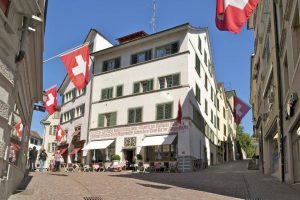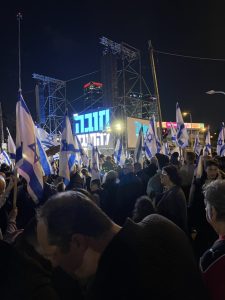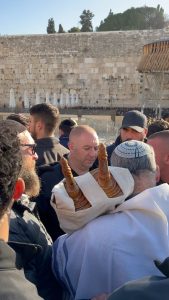The Niggun Ensemble shares Shiru L’Adonai
Shabbat Shalom
The Niggun Ensemble shares Shiru L’Adonai
Shabbat Shalom
The Niggunim Ensemble sings Psalm 96, Shiru L’Adonai, to help us welcome Shabbat.
Wishing everyone a Shabbat of Peace and wholeness.
Shabbat Shalom
As a rabbi in the community, I spend substantial time with interfaith couples. There is an undeniable trend with many Jews finding life partners with people of other faith traditions. It is a challenge that Judaism can successfully navigate. And hopefully, we can see the beauty and opportunity arising from such unions.
The story of Pinchas in Balak relates to a fear of intermarriage. It demonstrates how the Israelites were concerned about maintaining their community’s purity and adherence to God’s laws. In the story, the Israelites were seduced by the Moabite women. As a result, they began to engage in sexual immorality and idol worship, which threatened their relationship with God and their identity as separate people.
As a zealous and devout member of the Israelite community, Pinchas took matters into his own hands. He killed an Israelite man and a Midianite woman who were openly engaging in such behavior. His actions were seen as a necessary and just response to the threat of intermarriage and the resulting erosion of the Israelite community’s values and identity. This story speaks against intermarriage, then or now.
However, times have changed since the era depicted in the story of Pinchas. And indeed, this idea is not the first time Jews have seen borders and boundaries as porous, opportunities to engage new ideas and be enriched by them.
Judaism has a rich history of connecting with other cultures and incorporating new ideas, practices, and beliefs. Here are some specific examples of how Judaism has been enriched through its interactions with different cultures:
During the Babylonian Exile in the 6th century BCE, Jews were exposed to new ideas and practices from the Babylonian culture. This led to the development of new forms of Jewish scholarship and the compilation of the Babylonian Talmud, one of the central texts of Judaism.
In the Hellenistic Period in the 4th century BCE, Jews came into contact with Greek culture and philosophy. This led to the development of Hellenistic Judaism, which incorporated Greek ideas into Jewish thought. For example, Philo of Alexandria, a Hellenistic Jewish philosopher, used Greek philosophy to interpret the Hebrew Bible.
During the Islamic Golden Age in the 8th to 13th centuries CE, Jews lived in Muslim-majority societies and were exposed to Islamic culture and philosophy. This led to the development of Jewish philosophy, such as the works of Maimonides, who used Islamic philosophy to interpret Jewish theology.
Sephardic Jews originated in the Iberian Peninsula and had a rich cultural exchange with the Christian and Muslim cultures around them. This led to the development of Sephardic music, art, and cuisine, which have become integral and celebrated parts of Jewish culture.
The Hasidic movement emerged in Eastern Europe in the 18th century, incorporating mystical and ecstatic practices arguably adopted from the surrounding Slavic and Turkic cultures. This led to the development of Hasidic music, dance, and storytelling, which have become central to Hasidic culture and across many Jewish denominations.
In modern times, intermarriage is more widely accepted and celebrated, and many people see it as a positive way to build bridges between different cultures and communities. In many cases, intermarriage can help to promote understanding and reduce prejudice between groups. We are blessed to live in a place and time where we can marry the person we love because of whom they are rather than feel threatened or risk being ostracized.
When welcomed into Judaism’s embrace, these people also hold special esteemed status, known as a Ger Toshav. They have supported the Jewish community in which they live and enriched us. Although considered our “first convert,” Ruth may have been a Ger Toshav.
While some still hold on to the fear of intermarriage and seek to maintain the purity of their community, many people now recognize that diversity and intermarriage can be positive forces for social and cultural change.
Rather than fearing intermarriage, we can welcome those who choose it, seeing it as an opportunity for growth, connection, and understanding. Judaism rises to the occasion with its rich knowledge of its universal core values that are a foundation for creating a meaningful life. It also helps the 21st-century Jew see identity in an inclusive and embracing way.
Judaism has been enriched by its interactions with other cultures throughout history. These interactions have led to the developing of new ideas, practices, and beliefs, which have become integral parts of Jewish culture. Using the past as a prologue, we should welcome these couples with open arms.
Yedid Nefesh at the beginning of Kabbalat Shabbat, we are looking to find a way to bring us closer to God, setting the mood for welcoming Shabbat. Asaph Neve Shalom shares our love poem.
Shabbat Shalom
We are on the way to Sinai; Today is the 8th day of the Omer, which is one week and one day of the Omer. Another 41 days to go. It is an extraordinary journey. This song is a way of lightening the mood as we prepare to welcome Shabbat.
Shabbat Shalom
Profoundly important words capture what so many of us felt on our recent trip to Israel.
Thank you, rabbi, for sharing this complexity with such clarity.
In these particularly turbulent times, this pensive song from the incomparable Rabbi Debra Sacks Mintz is a soulful prayer to help us enter Shabbat.
May peace and wholeness come to all.
Shabbat Shalom
Feeling Conspicuous
 Wandering the streets of old Zurich, I felt conspicuous. As usual, I wore my Ukrainian Sunflower Kippah, which usually draws attention. But somehow, this time felt different. The medieval alleys and streets were charming; gassen and the strassen wound around, up and down hilly terrain. The cobblestones beneath our feet, the old-style buildings, and the lake uniquely charm Zurich. And I was generally comfortable in my surroundings. But I wondered if people were looking at the Kippah or the Jew.
Wandering the streets of old Zurich, I felt conspicuous. As usual, I wore my Ukrainian Sunflower Kippah, which usually draws attention. But somehow, this time felt different. The medieval alleys and streets were charming; gassen and the strassen wound around, up and down hilly terrain. The cobblestones beneath our feet, the old-style buildings, and the lake uniquely charm Zurich. And I was generally comfortable in my surroundings. But I wondered if people were looking at the Kippah or the Jew.
Switzerland was neutral during the war, of course. They tend to be neutral on most things except for commerce, where they have a very pro-business attitude. Zurich was not a city that experienced Nazi occupation or Jewish deportations. But the streets seemed strangely empty of Jews.
In a meeting with the liberal Rabbi of Zurich, he shared that it is a small Jewish community that gets along well. The more orthodox denominations do not mix with the more liberal ones, and several synagogues exist. Knowing this did not assuage my feelings as we wandered around a portion of the city where I was the identifiable Jew. The rabbi wore the only other kippah I saw.
I have walked the streets of many cities in many countries, clearly identifying myself by my kippah, so I am unsure why this experience seemed heightened. Perhaps the challenges in Israel, wherein orthodox political parties have pushed to define who is a Jew, have created a particular kind of angst.
In the United States, my kippah is a conversation starter. People often comment on my kippah, on the streets, or even at the orchestra. I use this kippah hoping to discuss supporting Ukraine war victims. I only received furtive glances here, except for the man at passport control. As I was leaving, he cheerfully commented on the kippah’s unique nature, giving me the opportunity to talk about Ukraine.
There is a saying that just because I am paranoid doesn’t make me wrong. But for now, I will chalk it up to my paranoia and continue to publicly and proudly identify who I am.
Love (with)… all your perfect imperfections
John Legend’s beautiful song All of me, inspired by his love for his wife, Chrissy, moved and inspired many of us with the romance. But what happens when reality falls so far short of the romantic vision, pushing the boundaries of acceptable, even tolerable? Unfortunately, divorce is often the result.
I am struggling with my relationship with Israel. The aspirations of our ancient homeland land and our history drew me to the miracle that was and, in many ways, continues to be this place. But the state is pressing on issues such as racism, tolerance for pluralism, and checks and balances in government. I was suckled in a mythic Israel but have learned to ween myself, given the practicalities of a nation-state that cannot live solely by the hopes and dreams of the Jewish people. However, as Ben Gurion understood, to be a nation like other nations. It was a pragmatic understanding of survival in the harsh real world. Today, the ideals of a homeland that is both Jewish and a democracy are threatened by raw political power and expediency.
We had come to accept Jewish and Democracy in tension. But, for the first time, we face the existential crisis of threatening both. The fractious rough and tumble nature of Israeli politics and the need to form a governing coalition in Knesset has brought us to a new place.
Over time, we developed complacency in our attitudes. Israel, as a Jewish Democratic state, was always considered a given. Laws and policies often were merely annoyances and opportunities for workarounds. “Religious” marriage meant a weekend in Cyprus. The orthodox church that has become the Kotel was not an issue for the secular. Israelis have enjoyed unprecedented prosperity and unrivaled military strength, making this a safe and secure place for most. Palestinian rights, west bank settlements, and civil rights were not on the radar screen of most and were relegated to the margins.
Then came Bibi 3.0. The assault on cherished rights, once considered unassailable, has awoken many from slumber. The protests in the streets by hundreds of thousands are sending a strong message that this is unacceptable. “Guns and butter” at any cost are not enough. The extensive unbridled settlement program is intolerable, and the Israeli terrorist response to terrorism is rightly called a pogrom. To use a familiar Jewish word, it is a Shanda.
 I struggle to love the country as I continue to love the land that held a people charged to be a light unto the nations. This is my heritage. Last week during my trip to Israel with the CCAR, I was proud to be at two demonstrations in Jerusalem and Tel Aviv. I was deeply moved to see the sea of Israeli flags and patriotism on display. However, I was disgusted and deeply aggrieved to be spat on when attempting to bring our Torah for Rosh Chodesh and assaulted by yeshiva bochers as trying to stop my expression of Judaism in the Kotel space.
I struggle to love the country as I continue to love the land that held a people charged to be a light unto the nations. This is my heritage. Last week during my trip to Israel with the CCAR, I was proud to be at two demonstrations in Jerusalem and Tel Aviv. I was deeply moved to see the sea of Israeli flags and patriotism on display. However, I was disgusted and deeply aggrieved to be spat on when attempting to bring our Torah for Rosh Chodesh and assaulted by yeshiva bochers as trying to stop my expression of Judaism in the Kotel space.
I cannot turn my back on this precocious and precarious experiment. But I am distraught. I support those who do the work, including the Israeli Religious Action Center and the brave Women of the Wall. I also proudly support NGOs who envision a place where people can live in a shared society, including the Yad b’Yad schools and the New Israel Fund, on whose regional board I serve. I am actively considering dual citizenship, not to lessen my devotion to the United States, but to achieve a voice in shaping the destiny of Israel as only a voting citizen can do. I urge everyone to evaluate where they stand and what they want to do at this critical juncture.
No one can sit on the sidelines any longer.